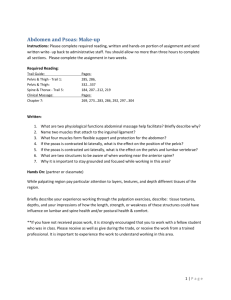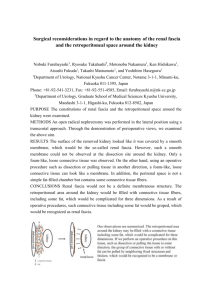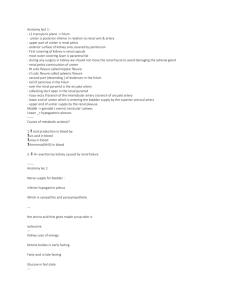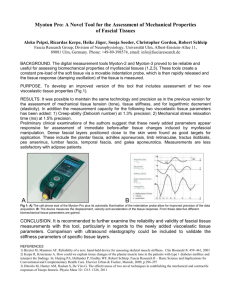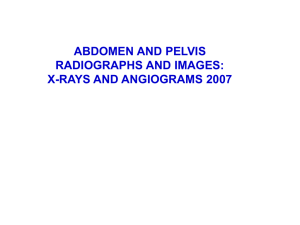approved
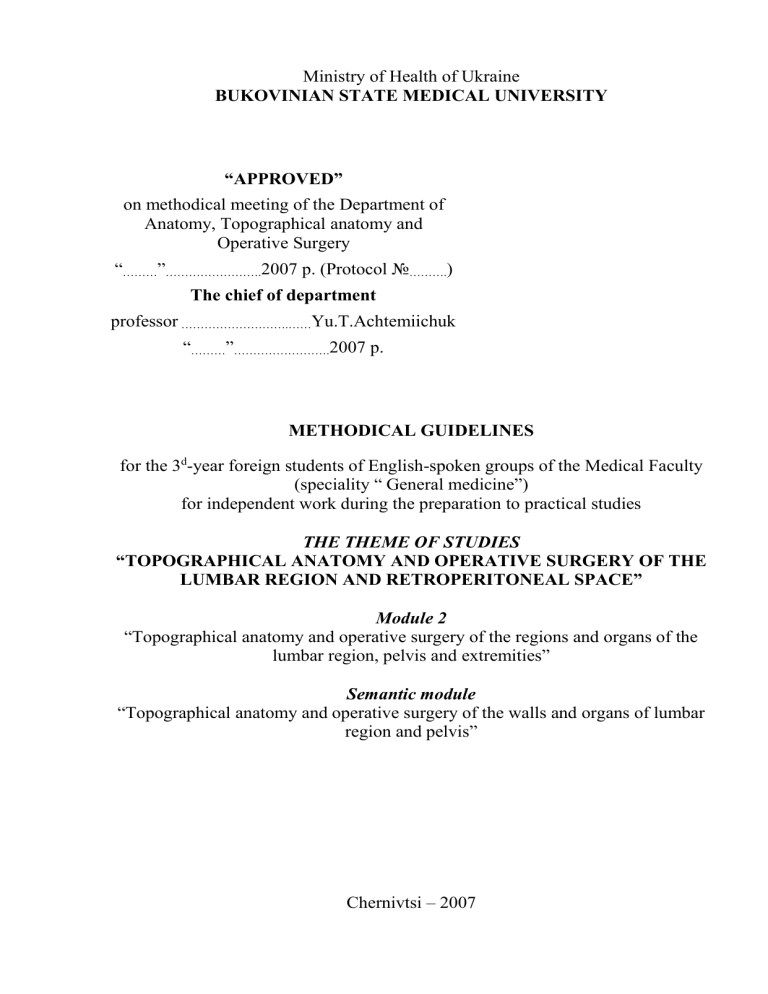
Ministry of Health of Ukraine
BUKOVINIAN STATE MEDICAL UNIVERSITY
“APPROVED” on methodical meeting of the Department of
Anatomy, Topographical anatomy and
Operative Surgery
“
………
”
…………………….
2007 р. (Protocol №
……….
)
The chief of department professor
……………………….……
Yu.T.Achtemiichuk
“
………
”
…………………….
2007 р.
METHODICAL GUIDELINES for the 3
d
-year foreign students of English-spoken groups of the Medical Faculty
(speciality “ General medicine”) for independent work during the preparation to practical studies
THE THEME OF STUDIES
“TOPOGRAPHICAL ANATOMY AND OPERATIVE SURGERY OF THE
LUMBAR REGION AND RETROPERITONEAL SPACE”
Module 2
“Topographical anatomy and operative surgery of the regions and organs of the lumbar region, pelvis and extremities”
Semantic module
“Topographical anatomy and operative surgery of the walls and organs of lumbar region and pelvis”
Chernivtsi – 2007
1. Actuality of theme:
The topographical anatomy and operative surgery of lumbar region and retroperitoneal space are very importance, because without the knowledge about peculiarities and variants of structure, form, location and mutual location of their anatomical structures, their age-specific and sexual properties it is impossible to diagnose in a proper time and correctly and to prescribe a necessary treatment to the patient.
2. Duration of studies: 2 working hours.
3. Educational purpose (concrete purposes):
To know peculiarities and variants of structure, form, location and mutual location of the lumbar region and retroperitoneal space.
To be able to define the borders, skeletotopy and projectors of the lumbar region and organs of the retroperitoneal space.
To master practical skills to make the extraperitoneal approach and vagosympathetic paranephral block.
4. Base knowledges, abilities, skills, that necessary for the study themes
(interdisciplinary integration):
The names of previous disciplines
1. Normal anatomy
2. Physiology
The got skills
To describe the structure and function of the different organs of the human body, to determine projectors and landmarks of the anatomical structures.
5. Advices to the student.
5.1. Table of contents of the theme:
Lumbar region
The bed of the posterior abdominal wall is made up of three bony and four muscular structures.
The bones are:
• ◊◊ the bodies of the lumbar vertebrae;
• ◊◊ the sacrum;
• ◊◊ the wings of the ilium.
The muscles are:
• ◊◊ the diaphragm—posterior part;
• ◊◊ the quadratus lumborum;
• ◊◊ the psoas major;
• ◊◊ the iliacus.
The diaphragm has been considered in the section on thorax.
The psoas must be dealt with in more detail because of the involvement of its sheath in the formation of a psoas abscess. The psoas major arises from the transverse processes of all the lumbar vertebrae and from the sides of the bodies and the intervening discs of T12 to L5 vertebrae. It passes downwards and laterally at the margin of the brim of the pelvis, narrowing down to a tendon which crosses the front of the hip joint beneath the inguinal ligament to be inserted, with iliacus, into the lesser trochanter of the femur. The psoas major, together with iliacus, flexes the hip on the trunk, or, alternatively, the trunk on the hips (e.g. in sitting up from the lying position). Psoas minor , absent in 40% of subjects, lies on psoas major and attaches to the iliopubic eminence.
Clinical features
1 ◊◊ The femoral artery lies on the psoas tendon in the groin, and it is this firm posterior relation of the femoral artery at the groin which enables it here to be identified and compressed easily by the finger.
2 ◊◊ The psoas is enclosed in the psoas sheath which is a compartment of the lumbar fascia. Pus from a tuberculous infection of the lumbar vertebrae is limited in its anterior spread by the anterior
longitudinal vertebral ligament, and therefore passes laterally into its sheath ( psoas abscess ), which may also be entered by pus tracking down from the posterior mediastinum in disease of the thoracic vertebrae.
Pus may then spread under the inguinal ligament into the femoral triangle where it produces a soft swelling. Occasionally, in completely neglected cases, pus tracks along the femoral vessels, along the subsartorial canal and eventually appears in the popliteal fossa.
The retroperitoneal organs are: the pancreas, kidneys and ureters (which have already been considered), the suprarenals, the aorta and inferior vena cava and their main branches, the para-aortic lymph nodes and the lumbar sympathetic chain.
Fascia of the Posterior Abdominal Wall
Each muscle in the posterior abdominal wall is enclosed in fascia. The name of the fascia is derived from the muscle(s) it encloses.
The Iliac Fascia. The iliopsoas fascia covering the psoas and iliacus muscles, is usually referred to as the iliac fascia (fascia iliaca). Although thin superiorly, it thickens inferiorly as it approaches the inguinal ligament. The part of the fascia covering the psoas major muscle, called the psoas fascia, is attached medially to the lumbar vertebrae and pelvic brim. Superiorly this fascia is thickened to form the medial arcuate ligament of the diaphragm. The fascia
Fascia of the Posterior Abdominal Wall
Each muscle in the posterior abdominal wall is enclosed in fascia. The name of the fascia is derived from the muscle(s) it encloses.
The Iliac Fascia. The iliopsoas fascia covering the psoas and iliacus muscles, is usually referred to as the iliac fascia (fascia iliaca). Although thin superiorly, it thickens inferiorly as it approaches the inguinal ligament. The part of the fascia covering the psoas major muscle, called the psoas fascia, is attached medially to the lumbar vertebrae and pelvic brim. Superiorly this fascia is thickened to form the medial arcuate ligament of the diaphragm. The fascia
Arteries of the Posterior Abdominal Wall
These arteries arise from the abdominal aorta, except for the subcostal arteries which are branches of the thoracic aorta.
The Subcostal Arteries. These arteries are the last branches of the descending thoracic aorta. They were given their name because they are located inferior to the costal margins, the intercostal arteries, and the 12th rib. Each artery runs laterally over the body of T12 vertebra and posterior to the splanchnic nerves, sympathetic trunk, pleura, and diaphragm. They enter the abdomen posterior to the lateral arcuate ligaments with the subcostal nerves (T12). They then run anterior to the quadratus lumborum muscle and posterior to the kidney, before piercing the aponeurosis of the origin of the transverses abdominis muscle and passing between this muscle and the internal oblique muscle. The subcostal arteries anastomose anteriorly with the inferior epigastric and inferior intercostal arteries and posteriorly with the lumbar arteries.
The Abdominal Aorta
The abdominal aorta is the continuation of the descending thoracic aorta. It begins at the aortic hiatus in the diaphragm at the level of the intervertebral disc between T12 and LI vertebrae and ends around the level of L4 vertebra by dividing into two common iliac arteries. Throughout its course the aorta lies against vertebral bodies.
The Relations of the Abdominal Aorta.
Anteriorly, the abdominal aorta is related to the celiac trunk and its branches, the celiac plexus, omental bursa, pancreas, left renal vein, ascending part of the duodenum, root of the mesentery, and intermesenteric plexus of nerves. Posteriorly, the abdominal aorta descends anterior to the bodies of LI to
L4 vertebrae, the intervening intervertebral discs, and the corresponding part of the anterior longitudinal ligament. On the right, the abdominal aorta is related superiorly to the cisterna chyli, thoracic duct, and right crus of the diaphragm. Inferiorly, it is related posteriorly to the inferior vena cava. On the left, the abdominal aorta is related superiorly to the left crus of the diaphragm and the left celiac ganglion. The duodenojejunal flexure is on its left, opposite L2 vertebra, and the sympathetic trunk runs along its left side.
Veins of the Posterior Abdominal Wall
The veins of the posterior abdominal wall are tributaries of the inferior vena cava, except for the left testicular (or ovarian) vein which enters the renal vein.
The Inferior Vena Cava
The inferior vena cava (IVC) is the largest vein in the body: it has no valves except for a variable, nonfunctional one that is located at its orifice. The IVC returns blood from the lower limbs, most of the
abdominal wall, and the abdominopelvic viscera. Blood from the viscera passes through the portal system and liver before entering the inferior vena cava via the hepatic veins. The IVC begins anterior to L5 vertebra by the union of the common iliac veins. This union occurs about 2.5 cm to the right of the median plane, inferior to the bifurcation of the aorta and posterior to the proximal part of the right common iliac artery. The IVC ascends on the right psoas major muscle to the right of the median plane and aorta. It passes through the vena caval foramen in the the diaphragm at the level of T8 vertebra. It then pierces the fibrous pericardium and enters the inferior part of the right atrium of the heart.
Relations of the Inferior Vena Cava. Posteriorly the IVC lies on the bodies of L3 to L5 vertebrae to the right of the aorta. It ascends on the right psoas major muscle, right sympathetic trunk, right renal artery, right suprarenal gland, right celiac ganglion, and the right crus of the diaphragm as it passes to the vena caval foramen. Anteriorly the relations of the IVC are the peritoneum, superior mesenteric vessels in the root of the mesentery, horizontal part of the duodenum, and head of the pancreas, with the portal vein and bile duct intervening. Superior to the first part of the duodenum, the IVC is posterior to the omental foramen. It then enters a groove on the inferior surface of the liver, between the right and caudate lobes.
To the left of the IVC is the aorta. To its right are the right ureter and kidney and the descending part of the duodenum.
Retroperitoneal Space
The retroperitoneal space lies on the posterior abdominal wall behind the parietal peritoneum. It extends from the twelfth thoracic vertebra and the twelfth rib to the sacrum and the iliac crests below. The floor or posterior wall of the space is formed from medial to lateral by the psoas and quadratus lumborum muscles and the origin of the transversus abdominis muscle. Each of these muscles is covered on the anterior surface by a definite layer of fascia. In front of the fascial layers is a variable amount of fatty connective tissue that forms a bed for the suprarenal glands, the kidneys, the ascending and descending parts of the colon, and the duodenum. The retroperitoneal space also contains the ureters and the renal and gonadal blood vessels.
THE KIDNEYS
The kidneys lie retroperitoneally on the posterior abdominal wall; the right kidney is 0.5 in (12 mm) lower than the left, presumably because of its downward displacement by the bulk of the liver. Each measures approximately 4.5 in (11 cm) long, 2.5 in (6 cm) wide and 1.5 in (4 cm) thick. Relations (Figs
80, 81)
• ◊◊
Posteriorly—the diaphragm (separating pleura), quadratus lumborum, psoas, transversus abdominis, the 12th rib and three nerves—the subcostal (T12), iliohypogastric and ilio-inguinal (L1).
• ◊◊
Anteriorly—the right kidney is related to the liver, the 2nd part of the duodenum (which may be opened accidentally in performing a right nephrectomy), and the ascending colon. In front of the left kidney lie the stomach, the pancreas and its vessels, the spleen, and the descending colon.
The suprarenals sit on each side as a cap on the kidney’s upper pole. The medial aspect of the kidney presents a deep vertical slit, the hilum , which transmits, from before backwards, the renal vein, renal artery, pelvis of the ureter and, usually, a subsidiary branch of the renal artery.
Lymphatics and nerves also enter the hilum, the latter being sympathetic, mainly vasomotor, fibres.
The pelvis of the ureter is subject to considerable anatomical variations (Fig. 82); it may lie completely outside the substance of the kidney (even to the extent of having part of the major calyces extrarenal) or may be almost buried in the renal hilum. All gradations exist between these extremes. If a calculus is lodged in the pelvis of the ureter, its removal is comparatively simple when this is extrarenal, and it is correspondingly difficult when the pelvis is hidden within the substance of the kidney.
Within the kidney, the pelvis of the ureter divides into two or three major calyces , each of which divides into a number of minor calyces. Each of these, in turn, is indented by a papilla of renal tissue and it is here that the collecting tubules of the kidney discharge urine into the ureter.
The kidneys lie in an abundant fatty cushion ( perinephric fat ) contained in the renal fascia (Fig.
83). Above, the renal fascia blends with the fascia over the diaphragm, leaving a separate compartment for the suprarenal (which is thus easily separated and left behind in performing a nephrectomy). Medially, the fascia blends with the sheaths of the aorta and inferior vena cava. Laterally it is continuous with the transversalis fascia. Only inferiorly does it remain relatively open— tracking around the ureter into the pelvis.
The kidney has, in fact, three capsules:
1 ◊◊ fascial (renal fascia);
2 ◊◊ fatty (perinephric fat);
3
◊◊ true—the fibrous capsule which strips readily from the normal kidney surface but adheres firmly to an organ that has been inflamed.
Blood supply
The renal artery derives directly from the aorta. The renal vein drains directly into the inferior vena cava. The left renal vein passes in front of the aorta immediately below the origin of the superior mesenteric artery. The right renal artery passes behind the inferior vena cava.
Lymph drainage
Lymphatics drain directly to the para-aortic lymph nodes.
Clinical features
1 ◊◊ Blood from a ruptured kidney or pus in a perinephric abscess first distend the renal fascia, then force their way within the fascial compartment downwards into the pelvis. The midline attachment of the renal fascia prevents extravasation to the opposite side.
2 ◊◊ In hypermobility of the kidney (‘floating kidney’), this organ can be moved up and down in its fascial compartment but not from side to side. To a lesser degree, it is in this plane that the normal kidney moves during respiration.
3 ◊◊ Exposure of the kidney via the loin . An oblique incision is usually favoured midway between the 12th rib and the iliac crest, extending laterally from the lateral border of erector spinae. Latissimus dorsi and serratus posterior inferior are divided and the free posterior border of external oblique is identified, enabling this muscle to be split along its fibres. Internal oblique and transversus abdominis are then divided, revealing peritoneum anteriorly, which is pushed forward. The renal fascial capsule is then brought clearly into view and is opened. The subcostal nerve and vessels are usually encountered in the upper part of the incision and are preserved.
If more room is required, the lateral edge of quadratus lumborum may be divided and also the 12th rib excised, care being taken to push up, but not to open, the pleura, which crosses the medial half of the rib.
THE URETER
The ureter is 10 in (25 cm) long and comprises the pelvis of the ureter and its abdominal, pelvic and intravesical portions. The abdominal ureter lies on the medial edge of psoas major (which separates it from the tips of the transverse processes of L2–L5) and then crosses into the pelvis at the bifurcation of the common iliac artery in front of the sacroiliac joint. Anteriorly, the right ureter is covered at its origin by the second part of the duodenum and then lies lateral to the inferior vena cava and behind the posterior peritoneum. It is crossed by the testicular (or ovarian), right colic, and ileocolic vessels. The left ureter is crossed by the testicular (or ovarian) and left colic vessels and then passes above the pelvic brim, behind the mesosigmoid and sigmoid colon to cross the common iliac artery immediately above its bifurcation.
The pelvic ureter runs on the lateral wall of the pelvis in front of the internal iliac artery to just in front of the ischial spine; it then turns forwards and medially to enter the bladder. In the male it lies above the seminal vesicle near its termination and is crossed superficially by the vas deferens. In the female, the ureter passes above the lateral fornix of the vagina 0.5 in (12 mm) lateral to the supravaginal portion of the cervix and lies below the broad ligament and uterine vessels. The intravesical ureter passes obliquely through the wall of the bladder for 0.75 in (2 cm); the vesical muscle and obliquity of this course produce respectively a sphincteric and valve-like arrangement at the termination of this duct.
Blood supply
The ureter receives a rich segmental blood supply from all available arteries along its course: the aorta, and the renal, testicular (or ovarian), internal iliac and inferior vesical arteries.
Clinical features
1
◊◊
The ureter is readily identified in life by its thick muscular wall which is seen to undergo worm-like (vermicular) writhing movements, particularly if gently stroked or squeezed.
2
◊◊
Throughout its abdominal and the upper part of its pelvic course, it adheres to the overlying peritoneum (through which it can be seen in the thin subject), and this fact is used in exposing the ureter— as the parietal peritoneum is dissected upwards, the ureter comes into view sticking to its posterior aspect.
3 ◊◊ The ureter is relatively narrowed at three sites:
• ◊◊ at the junction of the pelvis of ureter with its abdominal part,
• ◊◊ at the pelvic brim, and
• ◊◊ at the ureteric orifice (narrowest of all).
Aureteric calculus is likely to lodge at one of these three levels.
4
◊◊
In searching for a ureteric stone on a plain radiograph of the abdomen, one must imagine the course of the ureter in relation to the bony skeleton. It lies along the tips of the transverse processes, crosses in front of the sacroiliac joint, swings out to the ischial spine and then passes medially to the bladder. An opaque shadow along this line is suspicious of calculus.
This course of the ureter is readily studied by examining a radiograph showing a radio-opaque ureteric catheter in situ .
SUPRARENAL GLANDS
Location and description
The two suprarenal glands are yellowish retroperitoneal organs that lie on the upper poles of the kidneys. They are surrounded by renal fascia (but are separated from the kidneys by the perirenal fat).
Each gland has a yellow cortex and a dark brown medulla. The cortex of the suprarenal glands secretes hormones that include (a) mineral corticoids, which are concerned with the control of fluid and electrolyte balance; (b) glucocorticoids, which are concerned with the control of the metabolism of carbohydrates, fats, and proteins; and (c) small amounts of sex hormones, which probably play a role in the prepubertal development of the sex organs. The medulla of the suprarenal glands secretes the catecholamines epinephrine and norepinephrine.
The right suprarenal gland is pyramid shaped and caps the upper pole of the right kidney. It lies behind the right lobe of the liver and extends medially behind the inferior vena cava. It rests posteriorly on the diaphragm. The left suprarenal gland is crescentic in shape and extends along the medial border of the left kidney from the upper pole to the hilus. It lies behind the pancreas, the lesser sac, and the stomach and rests posteriorly on the diaphragm.
Blood supply
Arteries. The arteries supplying each gland are three in number: (1) inferior phrenic artery, (2) aorta, and (3) renal artery.
Veins. A single vein emerges from the hilum of each gland and drains into the inferior vena cava on the right and into the renal vein on the left.
Lymph drainage
Lateral aortic nodes.
Nerve supply
Preganglionic sympathetic fibers derived from the splanchnic nerves; most of the nerves end in the medulla of the gland.
5.2. Theoretical questions to studies:
1. Put the definishen of the landmarks and borders of the lumbar region and retroperitoneal space.
2. Layer-by-layer structure of lumbar region.
3. Weak points of lumbar region.
4. Fascial structure of lumbar region.
5. Blood supply of lumbar region.
6. Nervs of the lumbar region.
7. Lymphatic drainage of lumbar region.
8. Skeletotopy and projection of the retroperitoneal organs.
9. The topographical anatomy and operative surgery of the kidney.
10. The topographical anatomy and operative surgery of the suprarenal glands.
11. The topographical anatomy and operative surgery of the ureter.
12. Approaches to the retroperitoneal organs.
5.3. Practical tasks which are executed on studies:
1. localize the main organs of the retroperitoneal space.
2. Realize the approaches to the retroperitoneal organs.
5.4. Materials for self-control:
А.
Questions for self-control:
Select the best response:
1. All the following statements concerning the pelvis are true except:
A. The ilium, ischium, and pubis are three separate bones that fuse together to form the hip bone at the 25th year of life.
B. The platypelloid type of pelvis occurs in about 2% of women.
C. External pelvic measurements have little practical importance in determining whether a disproportion between the size of the fetal head and the size of the pelvic inlet is likely.
D. The pelvic outlet is formed by the symphysis pubis anteriorly, the ischial tuberosities laterally, the sacrotuberous ligaments laterally, and the coccyx posteriorly.
E. The sacrum is shorter, wider, and flatter in the female than in the male.
2. The following statements concerning structures that leave the pelvis are true except:
A. The sciatic nerve leaves the pelvis through the greater sciatic foramen.
B. The piriformis muscle leaves the pelvis through the greater sciatic foramen.
C. The external iliac artery passes beneath the inguinal ligament to become the femoral artery.
D. The obturator nerve leaves the pelvis through the lesser sciatic foramen.
E. The inferior gluteal artery leaves the pelvis through the greater sciatic foramen.
3. The following statements concerning the muscles and fascia in the pelvis are true except:
A. The levator ani muscle is innervated by the perineal branch of the fourth sacral nerve and from the perineal branch of the pudendal nerve.
B. In the pelvis the fascia is divided into parietal and visceral layers.
C. The iliococcygeus muscle arises from a thickening of the obturator internus fascia.
D. The pelvic diaphragm is strong and has no openings.
E. The visceral layer of pelvic fascia forms important ligaments that help support the uterus.
4. The following statements concerning the nerves of the pelvic cavity are true except:
A. The inferior hypogastric plexus contains both sympathetic and parasympathetic nerves.
B. The sacral plexus lies behind the rectum.
C. The pelvic part of the sympathetic trunk possesses both white and gray rami communicantes.
D. The superior hypogastric plexus is formed from the aortic sympathetic plexus and branches of the lumbar sympathetic ganglia.
E. The anterior rami of the upper four sacral nerves emerge into the pelvis through the anterior sacral foramina.
5. The following statements concerning the bony pelvis are true except:
A. When a patient is in the standing position, the anterior superior iliac spines lie vertically above the anterior surface of the symphysis pubis.
B. Very little movement is possible at the sacrococcygeal joint.
C. The false pelvis helps guide the fetus into the true pelvis during labor.
D. The female sex hormones cause a relaxation of the ligaments of the pelvis during pregnancy.
E. Obliteration of the cavity of the sacroiliac joint often occurs in both sexes after middle age.
Match the nerve below with the segmental origin:
6. Sciatic nerve
7. Pudendal nerve
8. Pelvic splanchnic nerve
9. Obturator nerve
A. L2, 3, and 4
B. L4, 5; SI, 2, 3
C. S2, 3, and 4
D. SI and 2
E. L3,4;S1,2
Match the artery below with its origin:
10. Superior rectal artery
11. Ovarian artery
12. Uterine artery
13. Middle rectal artery
14. Superior gluteal artery
A. Superior mesenteric artery
B. Abdominal part of aorta
C. Renal artery
D. Internal iliac artery
E. None of the above
Match the muscles of the pelvic walls listed below with the appropriate motor nerve supply.
Each lettered answer may be selected once or more than once:
15. Obturator internus
16. Iliococcygeus
17. Piriformis
18. Coccygeus
A. Lumbar plexus
B. Hypogastric plexuses
C. Sacral nerves or plexus
D. Sympathetic trunks
8. C
9. A
10. E
11. B
12. D
13. D
14. D
15. C
16. C
17. C
Answers to Questions
1. A
2. D
3. D
4. C
5. B
6. B
7. C
18. C
В. Test tasks for self-control:
STUDY THE FOLLOWING CASE HISTORIES AND SELECT THE BEST ANSWERS TO
THE QUESTIONS FOLLOWING THEM.
A 65-year-old man with a history of prostatic enlargement complained that he could not micturate.
The last time that he passed urine had been 6 hours previously. He was found lying on his bed in great distress, clutching his anterior abdominal wall with both hands and pleading for something to be done quickly. On examination, a large ovoid swelling could be palpated through the abdominal wall above the symphysis pubis.
1. In this patient the following facts are correct except:
A. In the adult the urinary bladder is a pelvic structure.
B. When the bladder fills the superior wall of the bladder rises out of the pelvis.
C. When the bladder becomes filled it never reaches a level above the umbilicus.
D. The swelling is dull on percussion.
E. Pressure on the swelling exacerbates the symptoms.
A 43-year-old woman was operated on in the perineum to drain an ischial rectal abscess. The abscess extended deeply to the region of the anorectal junction. The surgeon, to obtain better drainage, decided to cut the puborectalis muscle. Three days later the patient complained of fecal incontinence.
2. The symptoms displayed by this patient could be explained by the following facts except:
A. Anal continence is maintained by the tone of the internal and external sphincters and the puborectalis muscle.
B. The puborectalis fibers are a part of the levator ani muscle.
C. The puborectalis fibers pass around the anorectal junction.
D. The puborectalis muscle slings the anorectal junction up to the back of the body of the pubis.
E. The puborectalis muscle plays only a minor role in preserving anal continence.
A heavily built, middle-aged man running down a flight of stone steps misjudged the position of one of the steps and fell suddenly onto his buttocks. Following the fall he complained of severe bruising of the area of the cleft between the buttocks and persistent pain in this area.
3. The following facts concerning this patient are correct except:
A. The lower end of the vertebral column was traumatized by the stone step.
B. The coccyx can be palpated beneath the skin in the natal cleft.
C. The anterior surface of the coccyx cannot be felt clinically.
D. The coccyx is usually severely bruised or fractured.
E. The pain is felt in the distribution of dermatomes S4 and S5.
A 28-year-old pregnant woman was very frightened by the thought of going through the pain of childbirth. She asked her obstetrician if it was possible to relieve the pain without having a general anesthetic. She was told that she could have a relatively simple procedure called caudal anesthesia.
4. When performing caudal anesthesia the syringe needle is inserted into the sacral canal by piercing the following anatomic structures except:
A. Skin.
B. Fascia.
C. Ligaments.
D. Sacral hiatus.
E. Dura mater.
An elderly woman was run over by an automobile as she was crossing the road. X-ray examination of the pelvis in the emergency department of the local hospital revealed a fracture of the ilium and iliac crest on the left side.
5. The following facts about fractures of the pelvis are correct except:
A. Fractures of the ilium have little displacement.
B. Displacement is prevented by the presence of the iliacus and the gluteal muscles on the inner and outer surfaces of this bone, respectively.
C. If two fractures occur in the ring forming the true pelvis the fracture will be unstable and displacement will occur.
D. Fractures of the true pelvis do not cause injury to the pelvic viscera.
E. The postvertebral and abdominal muscles are responsible for elevating the lateral part of the pelvis should two fractures occur.
F. A heavy fall on the greater trochanter of the femur may drive the head of the femur through the floor of the acetabulum and into the pelvic cavity.
A pregnant woman visited an antenatal clinic. A vaginal examination revealed that the sacral promontory could be easily palpated and that the diagonal conjugate measured less than 4 inches.
6. The following facts concerning this examination are correct except:
A. Normally it is difficult or impossible to feel the sacral promontory by means of a vaginal examination.
B. The normal diagonal conjugate measures about 10 inches (25 cm).
C. This patient's pelvis was flattened anteroposteriorly, and the sacral promontory projected too far forward.
D. It is likely that this patient would have an obstructed labor.
E. This patient was advised to have a cesarean section.
ANSWERS TO CLINICAL PROBLEMS
1. C. In extreme cases of urethral obstruction in the male, the superior wall of the bladder has been known to reach the costal margin.
2. E. The puborectalis muscle is one of the most important sphincters of the anal canal.
3. C. The anterior surface of the coccyx can be palpated with a gloved finger placed in the anal canal.
4. E. The dura mater extends down in the sacral canal only as far as the lower border of the second sacral vertebra. It lies about 47 mm above the sacral hiatus in the adult.
5. D. Fractures of the true pelvis are commonly associated with injuries to the soft pelvic viscera, especially the bladder and the urethra.
6. B. The normal diagonal conjugate measures about 5 inches (11.5 cm).
Literature
1. Snell R.S. Clinical Anatomy for medical students. – Lippincott Williams
& Wilkins, 2000. – 898 p.
2. Skandalakis J.E., Skandalakis P.N., Skandalakis L.J. Surgical Anatomy and Technique. – Springer, 1995. – 674 p.
3. Netter F.H. Atlas of human anatomy. – Ciba-Geigy Co., 1994. – 514 p.
Сompiler, docent
Reviewer, docent
O.V.Tsyhykalo
O.M.Slobodian


